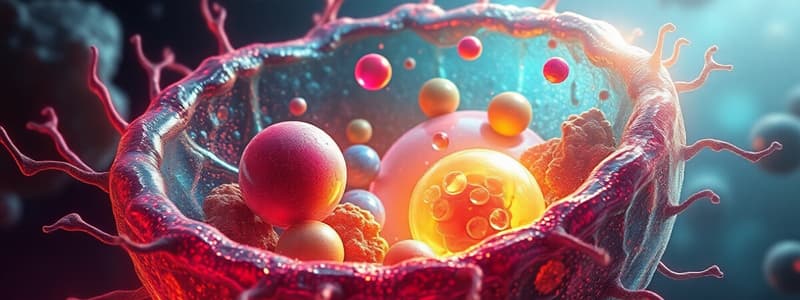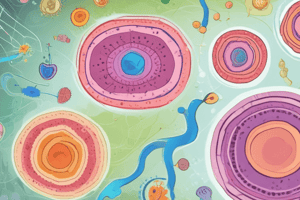Podcast
Questions and Answers
What is the primary function of the Golgi apparatus in a cell?
What is the primary function of the Golgi apparatus in a cell?
- To synthesize proteins directly
- To modify, sort, and pack proteins (correct)
- To create energy from food molecules
- To store genetic material
What is the role of lysosomes within a cell?
What is the role of lysosomes within a cell?
- To synthesize lipids and proteins
- To break down macromolecules into smaller molecules (correct)
- To store water and nutrients
- To assist in cell division
Which statement accurately describes a hypotonic solution in relation to a cell?
Which statement accurately describes a hypotonic solution in relation to a cell?
- The solvent concentration outside the cell is higher.
- The cell wall prevents lysis from occurring. (correct)
- The cell will shrink as water is drawn out.
- It leads to cells being in an equilibrium state.
What is the primary purpose of the cytoskeleton?
What is the primary purpose of the cytoskeleton?
What defines a selectively permeable membrane?
What defines a selectively permeable membrane?
What is the function of chloroplasts in a plant cell?
What is the function of chloroplasts in a plant cell?
What is a major difference between rough ER and smooth ER?
What is a major difference between rough ER and smooth ER?
What structure in a cell converts chemical energy from food molecules into usable energy?
What structure in a cell converts chemical energy from food molecules into usable energy?
Flashcards
Hypotonic solution
Hypotonic solution
A solution with a lower concentration of solutes than inside a cell.
Hypertonic solution
Hypertonic solution
A solution with a higher concentration of solutes than inside a cell.
Isotonic solution
Isotonic solution
A solution with the same concentration of solutes as inside a cell.
Cell membrane
Cell membrane
Signup and view all the flashcards
Cytoplasm
Cytoplasm
Signup and view all the flashcards
Organelle
Organelle
Signup and view all the flashcards
Cell Wall
Cell Wall
Signup and view all the flashcards
Selectively permeable membrane
Selectively permeable membrane
Signup and view all the flashcards
Study Notes
Cell Structure and Function
-
Cytoplasm: The fluid portion of the cell, outside the nucleus
-
Organelles: Specialized structures performing cellular functions within eukaryotic cells (small organs)
-
Nucleus: Holds nearly all the cell's DNA, directs protein and molecule production
-
Golgi Apparatus: Modifies, sorts, and packages proteins and materials from the ER for cell storage or release
-
Endoplasmic Reticulum (ER): Synthesizes lipids (including membrane components), proteins, and materials for export.
- Rough ER: Contains proteins for export, membrane proteins, and proteins for other cellular locations.
-
Vacuoles and Vesicles: Sacs storing water, salts, proteins, and carbohydrates
-
Selectively Permeable Membranes: Allow certain substances to pass through, but not others.
-
Lysosomes: Contain enzymes that break down lipids, carbohydrates, and proteins into usable molecules
-
Cytoskeleton: Maintains cell shape and facilitates internal movement.
-
Chloroplasts: Convert light energy into chemical energy during photosynthesis
-
Mitochondria: "Powerhouses" of the cell, convert food energy into usable compounds
-
Cell Wall: A strong, protective layer surrounding the cell membrane, providing support.
-
Cell Membrane: Outer boundary regulating what enters and exits the cell, protects and supports.
-
Lipid Bilayer: Two-layered sheet forming the cell membrane, acting as a barrier.
-
Microtubules: Hollow protein structures (tubulins) maintaining cell shape and involved in division.
-
Cilia: Short hair-like projections for movement
-
Flagella: Longer whip-like structures for movement in protists.
-
Microfilaments: Thread-like protein structures (actin) providing support and movement.
Cell Membranes and Tonicity
-
Hypotonic Solution: Water rushes into the cell, causing it to swell. Plant cells thrive in hypotonic solutions. Animal cells without walls may lyse (burst).
-
Hypertonic Solution: Water rushes out of the cell, causing it to shrink. Animal cells will shrivel.
-
Isotonic Solution: The concentration of solutes is balanced between the cell and the solution, and there is no net movement of water.
Studying That Suits You
Use AI to generate personalized quizzes and flashcards to suit your learning preferences.




